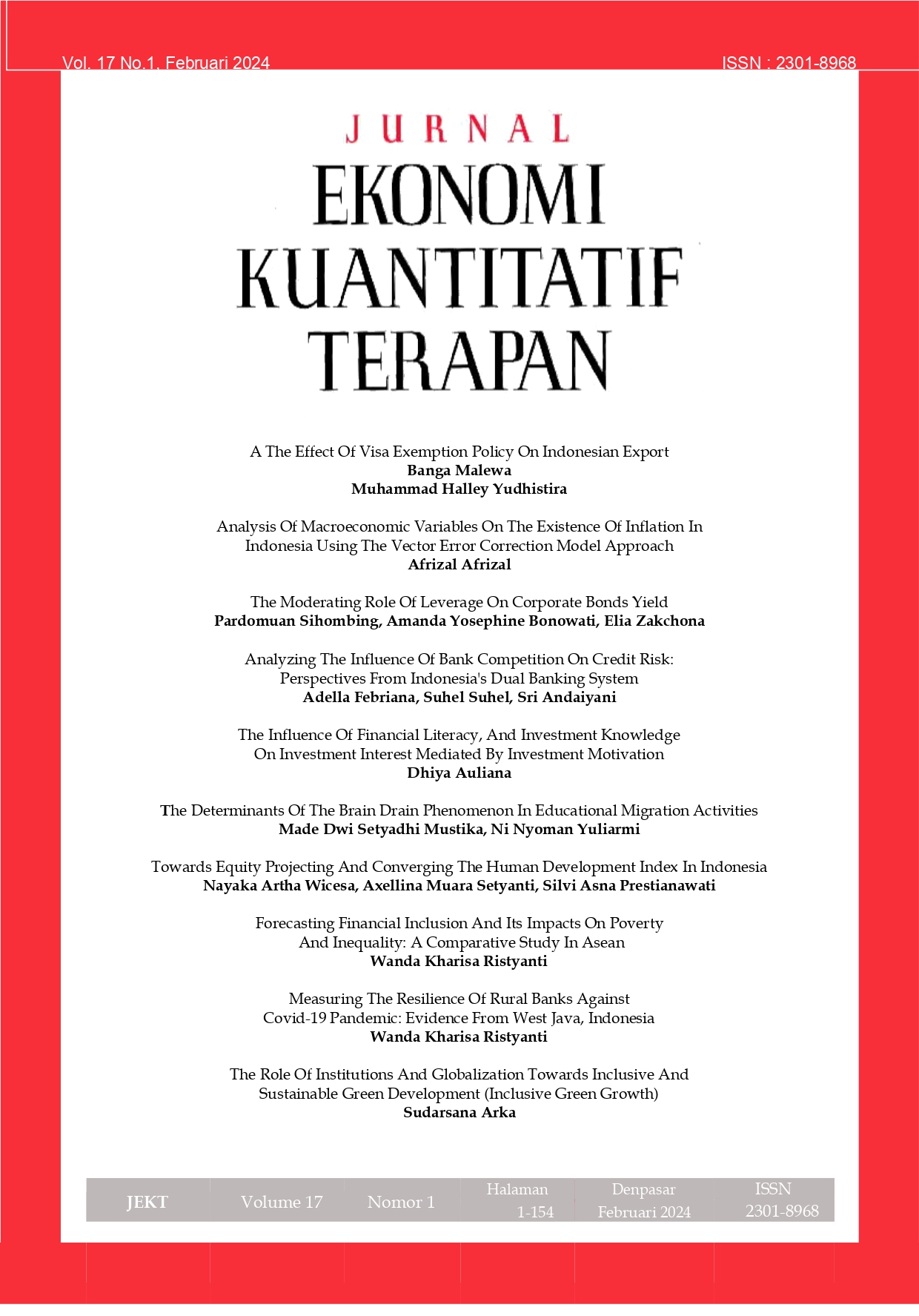Forecasting Financial Inclusion and Its Impacts on Poverty and Inequality: A Comparative Study in ASEAN
-
Abstract
Financial inclusion has played a vital role in eradicating poverty and inequality in some developing countries over the last few decades. In ASEAN, the growth of financial inclusion is so rapid that it reaches every element of society. Therefore, the purpose of this study is to examine forecasts of financial inclusion, poverty, and inequality in ASEAN. In addition, the study also analyzes the correlation between financial inclusion, poverty, and inequality in ASEAN. The study uses the ARIMA and GMM models for the study period from 2000 to 2022. Projections show that most ASEAN countries have experienced an increase in the long-term financial inclusion index, with Thailand leading the ranking, followed by Malaysia. However, the role of financial inclusion in poverty does not seem to be so significant in the short term, most likely due to the still-difficult access for low-income groups.
Downloads
References
Alvarez-Gamboa, J., Cabrera-Barona, P., & Jacome-Estrella, H. (2020). Territorial inequalities in financial inclusion: A comparative study between private banks and credit unions.
Arun, T., Kamath, R., 2015. Financial inclusion: policies and practices. IIMB Manag. Rev. 27 (4), 267–287
Babajide, A.A., Adegboye, F.B., Omankhanlen, A.E., 2015. Financial inclusion and economic growth in Nigeria. Int. J. Econ. Financ. Issues 5 (3), 629–637.
Bae K, Han D, Sohn H. (2012). Importance of access to finance in reducing income inequality and poverty level. Int. Rev. Public Adm. (17), pp. 55–77.
Banerjee AV, Duflo E. (2011). Poor economics: a radical rethinking of the way to fight global poverty. Hachette UK.
Bangoura L, Mbow MK, Lessoua A, Diaw D. (2016). Impact of microfinance on poverty and inequality: a heterogeneous panel causality analysis. Rev. D´ economie Polit., pp. 126:789–818.
Beck T, Levine R, Loayza N. (2000). Finance and the sources of growth. J Financ Econ. (58), pp. 261–300.
Boukhatem, J., (2016). Assessing the direct effect of financial development on poverty reduction in a panel of low-and middle-income countries. Res. Int. Bus. Finance 37, 214–230.
Bruhn M, Love I. (2014). The real impact of improved access to finance: evidence from Mexico. J Finance, (69), 1347–76.
Bui, M.T., & Luong, T.N.O. (2023). Financial inclusion for the elderly in Thailand and the role of information communication technology. Borsa Istanbul Review, 23-4, 818-833.
Chithra N, Selvam M. (2013). Determinants of financial inclusion: an empirical study on the inter-state variations in India. Rochester, NY: Social Science Research Network.
Cull R, Ehrbeck T, Holle N. (2014). Financial inclusion and development: recent impact evidence. Washington, D.C: CGAP.
Cumming, D., Johan, S., Zhang, M., 2014. The economic impact of entrepreneurship: comparing international datasets. Corp. Gov. Int. Rev. 22 (2), 162–178.
Demirgüç Kunt A, Klapper L. (2013). Measuring financial inclusion: explaining variation in use of financial services across and within countries. Brookings Pap Econ Activ, pp. 279–340.
Demirguc-Kunt A, Klapper L, Singer D. (2017). Financial inclusion and inclusive growth: a review of recent empirical evidence. Washington, DC: World Bank.
Erlando, A., Riyanto, F.D., & Masakazu, S. (2020). Financial Inclusion, Economics Growth, and Poverty Alleviation: Evidence from Eastern Indonesia.
Fenge, L.-A. (2012). Economic well-being and ageing: The need for financial education for social workers. Social Work Education, 31(4), 498–511. https://doi.org/10.1080/02615479.2011.579095
Klapper L, El-Zoghbi M, Hess J. (2016). Achieving the sustainable development goals: the role of financial inclusion. Washington, DC: CGAP.
Loukoianova, M. E., Yang, Y., Guo, M. S., Hunter, M. L., Jahan, M. S., Jamaludin, M. F., Rawat, U., Schauer, J., Sodsriwiboon, P., & Wu, M. Y. (2018). Financial inclusion in asia-pacific. International Monetary Fund.
McKillop D, French D, Quinn B, Sobiech AL, Wilson JOS. (2020). Cooperative financial institutions: a review of the literature. Int Rev Financ Anal. (71):101520.
Miled KBH, Rejeb J-EB. (2015). Microfinance and poverty reduction: a review and synthesis of empirical evidence. Procedia - Soc. Behav. Sci., pp. 195:705–12.
Neaime, S., Gaysset, I. (2018). Financial Inclusion and Stability in MENA: Evidence from Poverty and Inequality. Finance Research Letters.
Ouechtati (2020). The Contribution Of Financial Inclusion In Reducing Poverty And Income Inequality In Developing Countries. Asian Economic and Financial Review, 10(9), 1051-1061.
Pearce D. (2011). Financial Inclusion in the Middle East and North Africa, The World Bank Middle East and North Africa Region, Financial and Private Sector Development Unit.
United Nations. (2021). Sustainable development goals. Goal 1: end poverty in all its forms everywhere.
Erlando, A., Riyanto, F. D., & Masakazu, S. (2020). Financial inclusion, economic growth, and poverty alleviation: evidence from eastern Indonesia. Heliyon, 6(10), e05235. https://doi.org/https://doi.org/10.1016/j.heliyon.2020.e05235
Verma, A., & Giri, A. K. (2022). Does financial inclusion reduce income inequality? Empirical evidence from Asian economies. International Journal of Emerging Markets, ahead-of-print(ahead-of-print). https://doi.org/10.1108/IJOEM-02-2022-0271
Wong, Z. Z. A., Badeeb, R. A., & Philip, A. P. (2023). Financial Inclusion, Poverty, and Income Inequality in ASEAN Countries: Does Financial Innovation Matter? Social Indicators Research, 169(1), 471–503. https://doi.org/10.1007/s11205-023-03169-8




















